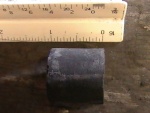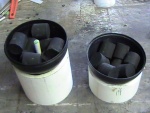Willow Stars
From PyroGuide
Willow is a type of Chrysanthemum that leaves a long-lasting golden tail in the air. To obtain the charcoal tail, the Potassium nitrate must be soaked into the Charcoal. Hence, a wet process must be used for mixing.
[edit] Compositions
Willow #1
| Lampblack | 54 |
| Potassium chlorate | 36 |
| Potassium nitrate | 4.5 |
| Dextrin | 4.5 |
Willow #2
| Potassium perchlorate | 30 |
| Lampblack | 30 |
| Charcoal, Pine Airfloat | 25 |
| Potassium nitrate | 10 |
| Dextrin | 5 |
| Shellac | 5 |
Willow #3
| Charcoal, Pine Airfloat | 45 |
| Potassium nitrate | 35 |
| Sulfur | 12 |
| SGRS or Dextrin | 8 |
Method
The procedure for making willow stars differs depending on who you talk to. Here is the summary, according to multiple sources combined:
All ingredients must be very fine, preferably ball milled. However, NEVER ball mill oxidizers and fuels together, with the exception of Potassium nitrate, Charcoal, and Sulfur. Those three only are stable enough to mill, but only with non-sparking media. Otherwise, ball mill separately and sieve the ingredients of your mixture together (whichever one you make).
Wet your mixture with the standard 75/25 water to isopropyl alcohol. The alcohol helps the water to be absorbed more readily and aids in the drying time as well. However, do not exceed 25% alcohol or it will impede the drying process of your stars and cause them to burn undesireably slow.
When uniformly wet to the point that the mixture just begins to clump when pressed between your fingers, screen pulverone style onto a non-absorbent drying surface. Allow it to dry completely. 48 hours should suffice in decent conditions. This process allows the Potassium nitrate to be absorbed into the pores of the charcoal.
The step that sets willow apart from most other compositions is as follows: Ball mill the pulverone for an additional time; depending on your ball mill, 1-3 hours. I know I just told you to break the rule I just told you above. However, apparently, once fine powdered, mixed , wet and dried, the sensitivity of the mix is decreased. Take extra caution anyway on this process in particular.
Once sufficiently milled, the mix is again made wet the very same way as outlined above, and finally pressed or cut (depending on your preference). I suppose you could roll the stars, though I haven't seen that method mentioned in willow stars. Rather, I've mostly encountered making cut stars, due to their ease of ignition.
Prime your stars in a compatible composition, i.e. the Potassium chlorate composition mentioned above should NEVER be primed with Black powder, or touch any composition containing Sulfur. The other two compositions can be primed with BP, as it is recommended for these mixtures.
[edit] Star Sizes
There is a great controversy over what size stars to use in willow shells. The standard for a willow shell is that the stars burn an extra long time, usually to just above the ground. Keeping that in mind, the average colored or effect star reaches only about 100 feet (30+ meters) from the shell. That means you have to make your stars larger even though the willow composition does burn slower than the average colored star.
One interpretation of a willow star is that it is not unlike a Dahlia, in that it has overly large stars (or Comets). One source stated that for a 12-inch shell, you should pump your stars (comets) to 1-3/4" by 1-3/4" long. These weren't primed immediately. After drying, the comets were wrapped with a few turns of craft paper, leaving 3/8" composition exposed on either end. The ends were re-wet and then primed.
According to that, I've set up a chart below according to shell size, burst height (common), and volume of star in order to figure the size of the pumped star. Note that some star sizes are unconventional, and may require "tweaking" in order to obtain the desired effect.
| Shell inch(mm) | Burst Height feet(m) | Star Volume (cubic inch) | Star size (inch) |
| 3 (76) | 400 (120) | 0.331 | 3/4" x 3/4" |
| 4 (102) | 500 (150) | 0.785 | 1" x 1" |
| 6 (152) | 700 (210) | 1.534 | 1-1/4" x 1-1/4" |
| 8 (203) | 900 (270) | 2.651 | 1-1/2" x 1-1/2" |
| 10 (254) | 1050 (320) | 3.370 | 1-5/8" x 1-5/8" |
| 12 (305) | 1150 (350) | 4.209 | 1-3/4" x 1-3/4" |
These measurements, again, are based on the break height of the shells and the volume of the stars (which will give an approximate burn time). In changing the diameter and length of the stars, you also must change the unwrapped surface area of the star on each end. In the 12" star, they leave 3/8" on each end unwrapped and primed. By the time you get to the 3" shell, you leave less than 1/8" uncovered and primed. However you do it, each star size and shell size needs testing and tweaking to be sure it is safe. Remember, you want your stars to burn out before they reach the ground. Somewhere around 20-30 feet above is good. If they hit the ground, they could light dry grass or trees and start a brush fire (bad for the unlicensed pyro).
[edit] Adjusting Burn Times
To adjust the burn time of your willow stars, several measures can be taken, all of which can improve your shell.
Stars burn too fast or do not get close to the ground
If you're using the correct diameter and length of stars per the chart above, then lengthening the star 10-20% will make it burn longer.
Change to the next bigger size star, but make it slightly shorter so it doesn't burn too long.
Again, test and retest your stars before you shoot them im front of a large crowd to avoid fires or injuries. Plus, the shame that comes from a shell not breaking right is devastating to a dedicated pyro.
Stars burn too slow and hit the ground
Making your star a little shorter (10-20%) will shorten the burn time.
Go to the next size smaller star and try making it slightly longer than suggested so it doesn't burn too short.
[edit] Quantities
It would be difficult to guess the amount of stars needed for different size shells, simply because all shells differ, and different star pumps make stars differently. A good way to help you guess is to make some sort of sizing template and then cut pieces of foam to match the same size as you want to make your stars. The image to the right is just an example of a 4" shell filled with 1" diameter x 1" length willow stars. The stars were pressed with a rather large syringe that was reinforced and pressed with a big metal vise. There are 15 stars in this particular shell. I originally made about 20 stars, which yielded from 250g of the Willow #2 formula above.
Each of the formulas for willow stars will shrink significantly while drying. Somewhere around 180-220% compression took place between the wet composition and the finished pressed stars. It would be a good idea to make twice as much as you think you need to make the stars, and that way you'll always have extra and not be lacking when it comes time to build your shells. For a complete tutorial, please see Willow Shell (4").


